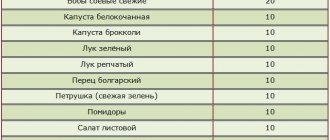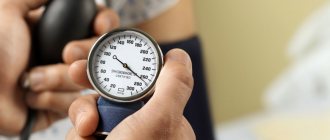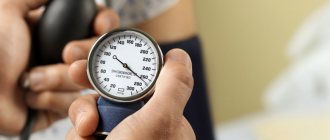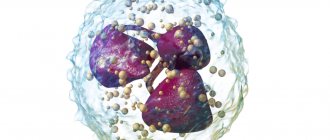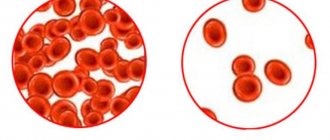Many people tend to believe that the problems of hypotension and hypertension occur only in adults and the elderly, and that they do not bother children aged 10–12 years. However, doctors claim that many teenagers in this age range suffer from symptoms of decreased or increased blood pressure (BP).
But due to their practically asymptomatic course, pathologies often go unnoticed. Every parent needs to know what the normal blood pressure is for a 12-year-old child, since at this age the child’s body undergoes significant changes - puberty, hormonal imbalances, etc.
What blood pressure is considered normal for children?
Blood pressure is an indicator that changes with age, and the lowest values are recorded in the first month of life, reaching 60–80 systolic and 40–50 diastolic (in mmHg). As the body switches to a pulmonary form of breathing, and the heart and vascular system becomes more advanced, these indicators change.
And only at the age of 15 the numbers on the tonometer of a teenager become equal to those of an adult. The table below will show you more about what blood pressure a 12-year-old child should have.
| Age limits | Level, mmHg Art. | |
| Systolic | Diastolic | |
| First 2 weeks – neonatal period | 60–96 | 40–50 |
| From 2 to 4 weeks – neonatal period | 80–112 | 40–74 |
| From 1 to 12 months – infant stage | 90–112 | 50–74 |
| From 1 to 3 years – early childhood | 100–112 | 60–74 |
| From 3 to 6 years – preschool period | 100–116 | 60–76 |
| From 6 to 9 years - early school stage | 100–122 | 60–78 |
| From 9 to 12 – middle school age | 110–126 | 70–82 |
| From 12 to 15–17 – senior school period | 110–136 | 70–86 |
It should be clarified that normal blood pressure is individual for each 12-year-old child and it cannot be constant. This indicator of the functioning of the heart and blood vessels depends on many factors:
How to measure blood pressure with an automatic tonometer
- living environment and climatic conditions - in mountainous and tropical climates, residents have low tonometer readings;
- the amount of table salt that the child consumes during the day;
- fetal full-term - as a rule, infants born prematurely have lower blood pressure than full-term newborns;
- active lifestyle – at a young age, intense physical activity leads to increased blood pressure in children. As you grow older, regular physical activity helps to stabilize the tonometer readings and fix them at 120/100;
- correct measurement technique - if the rules of tonometry are not followed, the device may show distorted results;
- the height of the child - the taller it is, the higher the pressure readings will be.
Doctors advise even children to periodically measure their blood pressure if there are visible changes in behavior and health.
If we summarize medical statistics and consider the question of what the blood pressure should be in children aged 12 years, we can answer - up to 10 years, 110/70 is acceptable, after 10-11 years, 120/80. There are also differences in tonometer readings depending on the gender of the child.
From birth until the age of one, babies of both sexes have equal blood pressure. Then it becomes higher in girls, leveling off again only by the age of five. Further, until the age of 10, girls are again in the lead, and after that the numbers on the tonometer become higher for boys.
No ads 1
Pediatricians:
Avzalova Daria Evgenevna
Pediatrician, neonatologist
Experience: 17 years Reviews: 7
Call to home
Barzenok Tatyana Arsenyevna
Head of the pediatric department, pediatrician of the first category
Experience: 27 years Reviews: 17
Make an appointment Call at home
Belousova Elena Sergeevna
Pediatrician, nephrologist
Experience: 17 years Reviews: 14
Make an appointment Call at home
Bykov Mikhail Viktorovich
Pediatrician of the highest category, ultrasound diagnostics specialist, Candidate of Medical Sciences
Experience: 24 years Reviews: 3
Make an appointment Call at home
Kazakova Liliya Valentinovna
Pediatrician, neonatologist, head of the breastfeeding consultant service
Experience: 27 years Reviews: 31
Make an appointment Call at home
Sedova Maria Sergeevna
Pediatrician, allergist-immunologist
Experience: 19 years Reviews: 30
Make an appointment Call at home
Sergienko Tatyana Yakovlevna
Pediatrician, pediatrician on duty at the pediatric hotline
Experience: 38 years Reviews: 21
Make an appointment
Correct measurement
To correctly determine the pressure in a 12-year-old child, you need to start by studying the correct algorithm for the procedure. It consists of the following:
- the width of the device cuff must be at least 40% of the arm circumference;
- the cuff fits the arm 80–100%;
- measurements are taken alternately on both hands twice, with an interval of 5–10 minutes;
- with regular pressure drops in children, it is recommended to take measurements twice a day for a week, and write the results in a notebook;
- do not measure indicators immediately after a heavy lunch or active physical activity - half an hour should pass after eating food and 10-15 minutes after intense movement;
- choose a sitting position for the procedure;
- the hand should lie on the table top, and the child sits silently, does not talk or move.
This is the only way to record correct results, without errors. By the way, to measure a child’s blood pressure it is better to use a manual rather than an automatic tonometer. Such devices are more accurate, and the measurement error is only 3–5 units.
Causes and symptoms of low blood pressure in children
During puberty, adolescents often complain of deteriorating health. One of the reasons for this condition is considered to be low blood pressure. However, a decrease in tonometer readings can also be considered as a variant of the norm if the child is active, feels well and has no health complaints. The physiological norm here is associated with the structural features of the nervous system, when its parasympathetic department is more active.
The age of 12–13 years is a period in children when active maturation of all internal organs and systems occurs, hormonal levels change, and the puberty phase begins
You can suspect incipient health problems based on a number of negative signs:
- weakness, complaints of fatigue and lack of the child’s usual activity;
- dizziness and loss of appetite;
- regular pain in the head;
- sudden attacks of nausea, pale skin, increased sweating;
- tendency to faint.
No ads 2
Low blood pressure in children aged 12 years is observed for a number of reasons. This may be a consequence of somatic and infectious diseases suffered by the mother during pregnancy, poisoning, alcohol abuse or smoking. Also, low tonometer levels can signal a large amount of liquor fluid inside the skull, the presence of chronic foci of infection in the body and hormonal imbalance.
The psycho-emotional sphere of the child also plays an important role in lowering blood pressure.
If he is stressed, often gets offended and cries, and has problems communicating with peers, the teenager clearly has symptoms of low blood pressure. Also, a similar problem is often identified in children growing up in unfavorable social conditions, in single-parent families, where the child is forced to work a lot and have little rest.
Increasing tonometer readings
A 12-year-old child is considered to have high blood pressure if the numbers on the tonometer regularly show above 130/80 mmHg. Under certain conditions, a single recorded high blood pressure is not considered a pathology if it is caused by anxiety, stress, excessive physical activity or injury.
But the constantly changing numbers on the tonometer indicate one of two options for childhood hypertension. The primary disease is also called mild, with pressure levels increasing gradually, and in the secondary form of hypertension, high systole and diastole values are immediately recorded.
Often, childhood hypertension is asymptomatic; an increase in pressure can be guessed by the following blurred signs:
- sudden headaches radiating to the temples and back of the head;
- redness of the face and neck;
- shortness of breath at rest;
- excessive excitability and anxiety.
No ads 3
More severe symptoms require daily blood pressure monitoring and a mandatory visit to a specialist for examination. The doctor may suspect damage to the kidney tissue, changes in the condition of blood vessels, diseases of the endocrine and nervous system, side effects from taking medications and other reasons.
Experts believe that the main reasons for the increase in blood pressure in adolescents aged 12–13 years are:
- nephropathy of various etiologies;
- abnormal structure of kidney tissue;
- neoplasms of benign and malignant nature;
- glomerulonephritis is a disease in which the glomeruli of the kidneys become inflamed;
- glomerulosclerosis is a pathology characterized by destructive changes in kidney tissue;
- hydronephrosis is a pathology in which the volume of the calyces and pelvis of the kidney increases, the glomeruli undergo compression and change, and the organ itself ceases to function over time;
- Alport syndrome - this affects not only the renal system, but also visual and auditory function.
Only a specialist can identify the true cause of high blood pressure in a teenager and choose the optimal method of treatment. Often the problem is asymptomatic, and you can suspect something is wrong by the child’s mood swings, irritability and outbursts of aggression, loss of usual performance and decreased performance at school.
Most often, it is possible to stabilize blood pressure levels by identifying and eliminating the root cause of the problem. If this is a hormonal change in the body, then it should end by the age of 13–14; parents just need to be patient. Permissible pressure limits for children aged 12 to 14 years are from 100/70 to 130/90 mmHg.
Causes of increased intracranial pressure or hydrocephalus may include:
- congenital abnormalities of brain development;
- perinatal infectious, hypoxic, traumatic processes;
- tumors;
- meningitis;
- injuries;
- hereditary metabolic and degenerative brain diseases, etc.
In any case, intracranial hypertension syndrome has similar clinical manifestations . This is a headache, mainly in the morning, without clear localization, bursting, intensifying in paroxysms, often accompanied by vomiting, not associated with food intake. The headache intensifies when coughing, sneezing, or straining. Additional symptoms: a feeling of “fog” before the eyes after being in a bent position, lethargy.
How to help your child stabilize blood pressure
If the heart rate is high, you should not delay a visit to the doctor, especially against the backdrop of large numbers on the tonometer. In general, if after examination doctors have not identified dangerous pathologies, and the pressure fluctuates periodically, the following recommendations will help the child:
- Maintaining a daily routine. Many teenagers and their parents neglect the golden rule of going to bed and getting up at the same time, providing the body with a full 8-9 hours of rest. As a result, biological rhythms are disrupted, and internal organs and systems react to this in a negative way, including surges in blood pressure.
- Proper nutrition. Here we are talking not only about a set of products, but also about following a meal regimen. A teenager needs to be taught to eat at the right time, not to overeat at night, and to keep his weight under control. Many 12-13 year old children at this age lay the foundation for subsequent obesity and health problems through poor nutrition.
- Rejection of bad habits. Teenagers during puberty often try smoking and drinking alcohol. Parents may not be aware of this, but the child’s body reacts to the ingestion of toxins by decreasing or increasing blood pressure.
- Physical activity. How much time should a teenager spend in front of a TV screen or computer? No more than two hours a day, otherwise the situation is no longer considered healthy. It is not necessary to send a 12-year-old child to the section for high sports achievements. Frequent walks in the fresh air, jogging, walking, swimming or gymnastics will be enough.
- Limiting intellectual and emotional overload. The child must be protected from family quarrels, scenes of violence on TV, and conflicts on the street. There is no need to demand excellent academic performance from a teenager if it is difficult for him. Excessive mental stress, combined with failure at school, will further aggravate your psycho-emotional state and health problems.
It is important to pay attention when measuring pressure not only to the numbers obtained, but also to the pulse
The listed points are very important in fulfilling the task of increasing or decreasing blood pressure in a teenager. A child of 12 years old cannot yet independently control his lifestyle, nutrition and intensity of exercise, so the responsibility falls on the shoulders of the parents. What normal blood pressure is typical for children at this age is now clear.
The task of parents is to closely monitor the child’s well-being and promptly contact a specialist if necessary. You need to understand that lowering blood pressure on your own at home is possible, but raising it is not always possible, especially if the child’s blood pressure levels have dropped to critical levels.
If a doctor insists on hospitalizing a teenager for a full examination and suspects the presence of a disease, do not refuse. Timely detected pathology will be eliminated faster, and the tonometer readings will be restored as the cause of their jumps is eliminated.
Diagnostic and treatment methods
Diagnosis of headaches in a child at the Clinical Brain Institute uses modern equipment and a team of specialized specialists. When the first symptoms appear, you should consult a pediatrician, and then you may need to consult an ophthalmologist, neurologist, surgeon, or otolaryngologist. To make an accurate diagnosis, a number of examinations are carried out:
- ultrasound diagnostics of cerebral vessels;
- X-ray of the cervical spine;
- MRI of the head is one of the most informative methods;
- electroencephalography - assessment of the functioning of various nervous structures.
Treatment is selected individually. In most cases, the headache goes away with age, but in some patients it persists throughout life. At home, you should provide your child with adequate rest and the required level of physical activity, minimize screen time, and provide adequate nutrition. Drug treatment includes taking analgesics (painkillers), antispasmodics, vitamins and drugs for correcting cerebral circulation. In our clinic you can get more detailed recommendations for the treatment of headaches in children of different ages, depending on the results of the examination.

